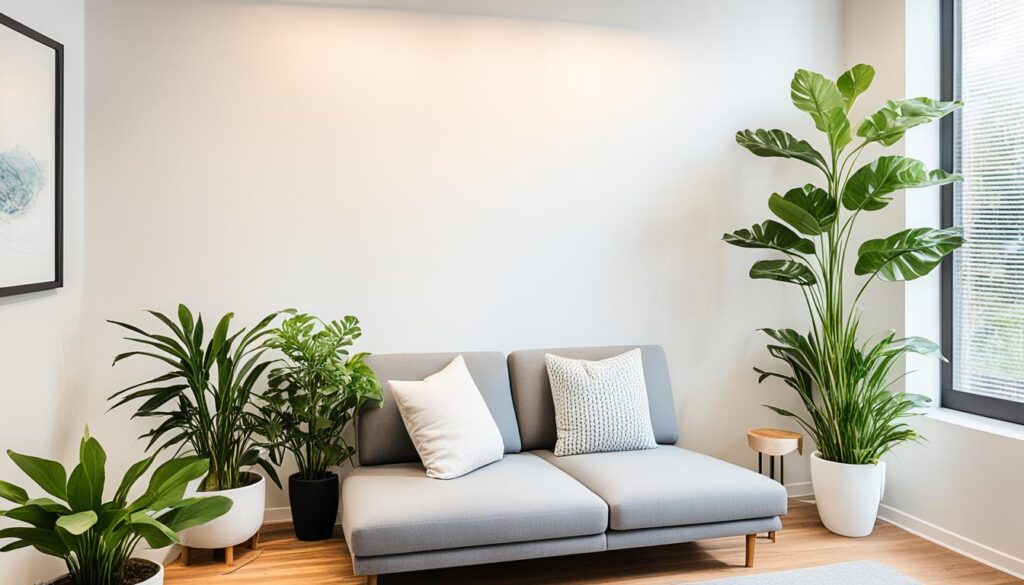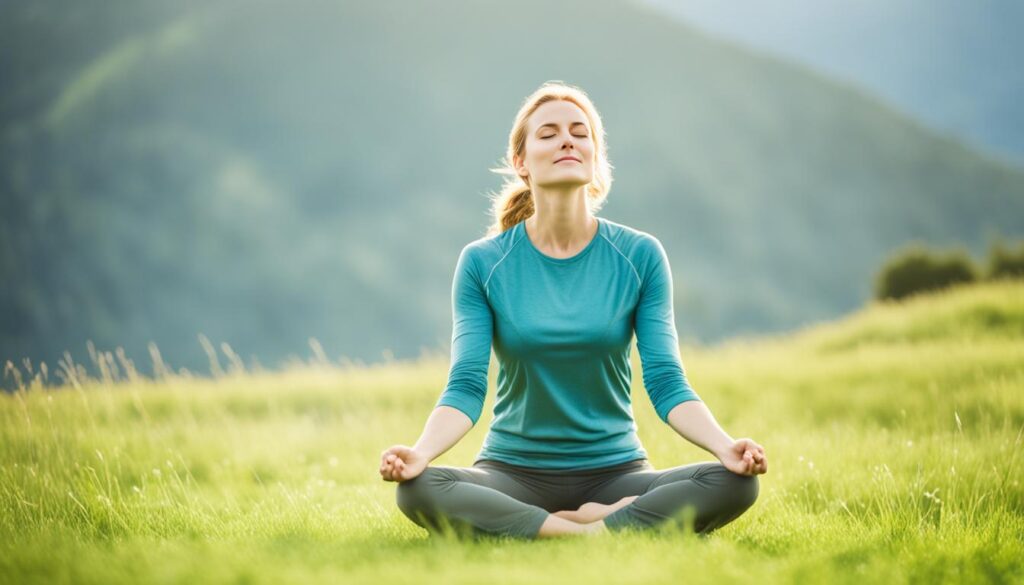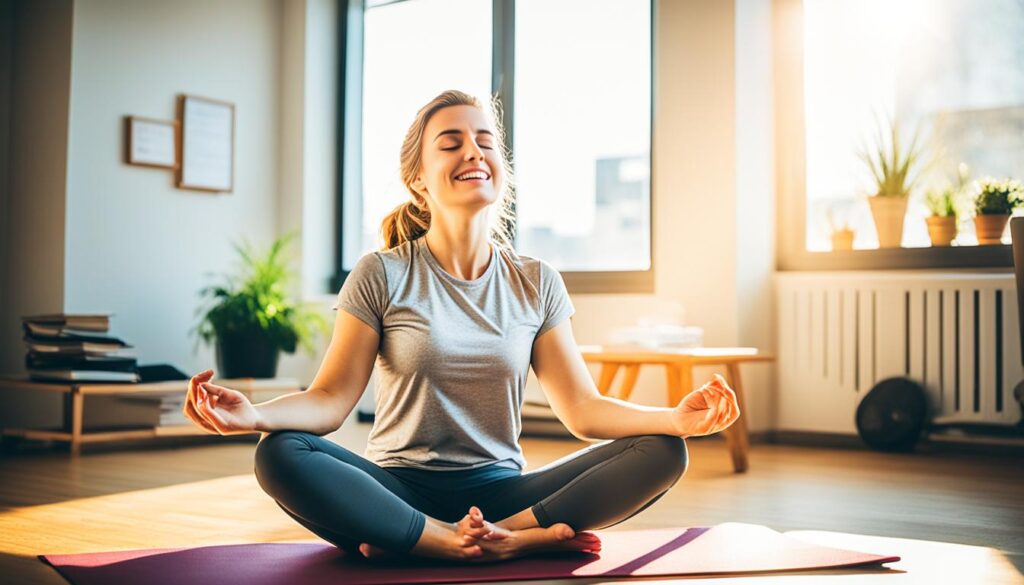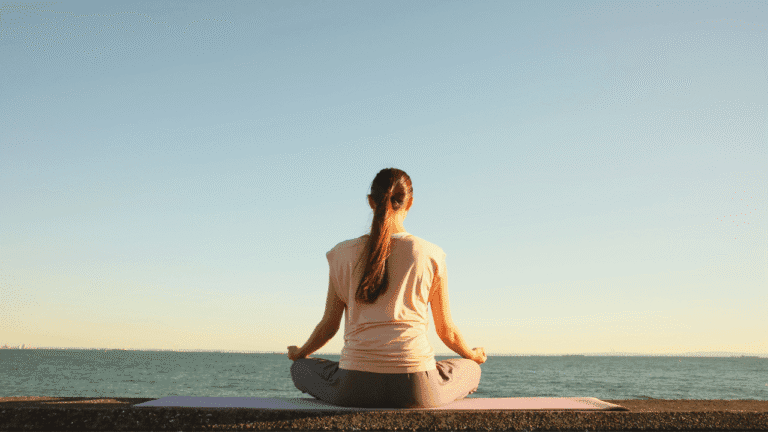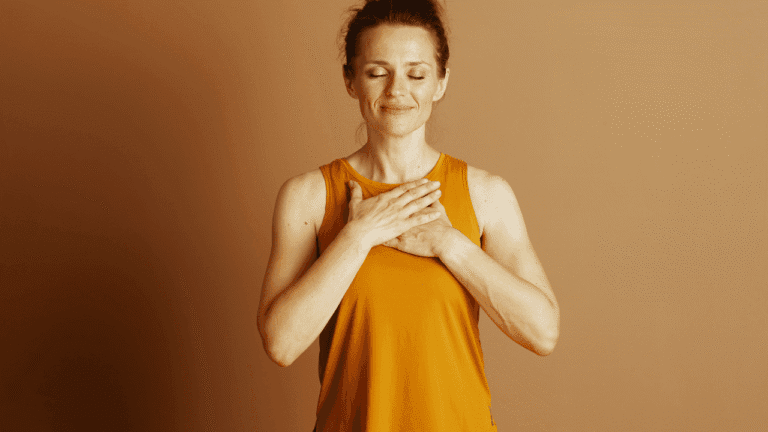How to practice Mindfulness for Beginners Easy Steps to Start
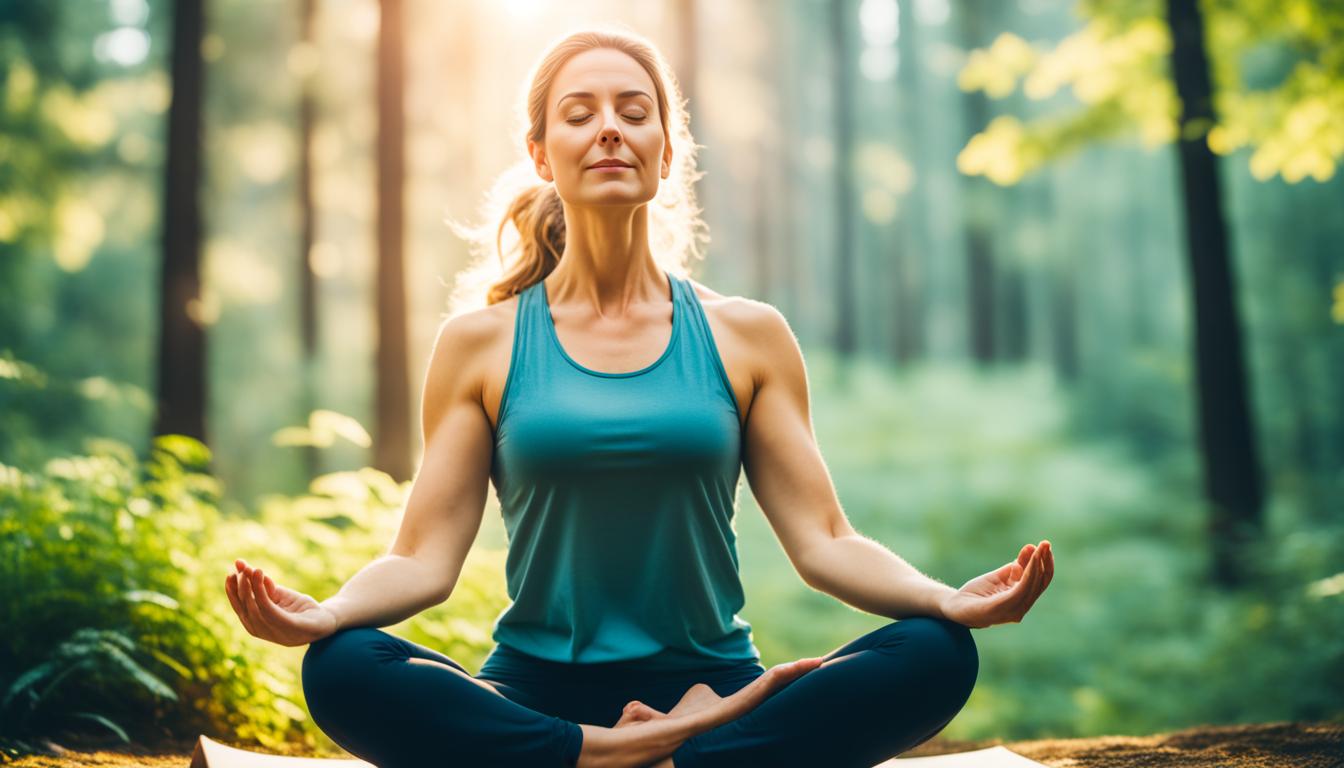
Mindfulness is a powerful way to change your life. It helps you stay in the moment, aware, and focused. If you want to reduce stress, manage anxiety, or find peace, this guide is for you. It offers tools and techniques to start your mindfulness journey.
Mindfulness means being fully present and aware of what’s around you. It’s a natural ability, but practicing it daily can make it easier to access. This can lead to many benefits.
Studies show that regular mindfulness can reduce depression and anxiety. It can also improve attention, memory, and how you handle emotions. A 2010 study found that daily mindfulness sessions for 8 weeks made brain areas related to learning and emotion thicker.
If you’re facing stress at work, relationship issues, or daily life pressures, easy mindfulness practices can help. They offer a break and help you become more resilient and well. So, if you’re ready, here’s a step-by-step guide to mindfulness. It will help you start a practice that can change your life.
Key Takeaways
- Mindfulness is the practice of being fully present and aware in the current moment
- Regular mindfulness practice can reduce stress, anxiety, and negative emotions
- Studies have shown that mindfulness can improve attention, memory, and emotional regulation
- Mindfulness can be practiced through simple techniques like breathing exercises and body scans
- Building a consistent mindfulness practice can lead to greater resilience and overall well-being
Understanding Mindfulness
Mindfulness is getting more popular, with people adding it to their daily routines. It’s about understanding the present moment and watching our thoughts and feelings without judging them.
What is Mindfulness?
Jon Kabat-Zinn, a well-known mindfulness teacher, defines it as “awareness that arises through paying attention, on purpose, in the present moment, nonjudgmentally” (Kabat-Zinn, 2016). This means being curious and open about our experiences without getting caught in our thoughts or reactions.
You can practice mindfulness through meditation or everyday activities. For example, eating, walking, or talking can become mindful. This helps us feel more connected and understand ourselves better.
“Mindfulness is about attention, not the specific activity.” – Jon Kabat-Zinn
Benefits of Mindfulness Practice
Starting with mindfulness has many benefits. Studies show it helps with focus, reduces stress, and makes us feel better overall. It teaches us to watch our thoughts and feelings without getting lost in them.
It also improves our health, like lowering blood pressure and easing chronic pain. Plus, it makes our relationships and communication better. Being present and aware in our interactions helps us connect deeper with others.
If you want to try mindfulness, there are many resources to help you start. Mindfulness exercises can be simple, like focusing on your breath or eating mindfully. With practice, mindfulness can become a part of your life, making it easier to handle life’s ups and downs.
| Mindfulness Practice | Benefits |
|---|---|
| Mindful Breathing | Reduces stress, improves focus and concentration |
| Body Scan Meditation | Increases body awareness, reduces tension and pain |
| Mindful Movement (Yoga, Tai Chi, Qigong) | Enhances physical and mental well-being, improves balance and flexibility |
| Mindful Eating | Promotes healthy eating habits, improves digestion and satisfaction |
Whether you’re new to mindfulness or have been practicing for a while, there’s always more to learn. Adding guided meditation for beginners and other mindfulness techniques to your day can bring more presence, resilience, and well-being into your life.
Setting the Foundation for Mindfulness
Starting a mindful living journey can be very rewarding. To begin, create a good environment, pick the best time, and get your mind and body ready.
Creating a Suitable Environment
Look for a quiet, comfy spot for mindfulness without distractions. It could be a special corner at home, a peaceful outdoor area, or a quiet room at work. Make sure it’s clean, has good air flow, and is at a nice temperature. Add things like plants, candles, or calming art to help you relax.
Choosing the Right Time
Being consistent is important for a mindfulness routine. Pick a specific time each day for your practice, like early morning, during lunch, or before bed. Pick a time when you won’t be interrupted and can focus fully. Even a short mindfulness session can greatly improve your well-being.
| Time of Day | Benefits |
|---|---|
| Morning | Sets a positive tone for the day, enhances focus and clarity |
| Midday | Provides a mental break, reduces stress, and boosts productivity |
| Evening | Promotes relaxation, aids in unwinding, and improves sleep quality |
Preparing Your Mind and Body
Before starting your mindfulness practice, get your mind and body ready. Sit comfortably, either on a cushion or a chair. Keep your back straight but relaxed, and let your shoulders drop. Place your hands on your thighs or in your lap, and soften your gaze or close your eyes.
Take a few deep breaths, focusing on how the air moves in and out of you. Notice any thoughts or feelings without judging them, and gently focus on your breath again. This simple step calms your mind and prepares you for mindfulness.
Mindfulness is not about being perfect. It’s about being present and aware, moment by moment, with kindness and curiosity.
Building a daily mindfulness routine takes time and patience. Be kind to yourself as you start, and celebrate your small wins. With regular effort and commitment, you’ll see how mindfulness can change your life.
Simple Mindfulness Techniques for Beginners
Starting your mindfulness journey with simple techniques is key. These include meditation, mindful movement, mindful eating, and body scans. They don’t need special gear or experience, making them easy for anyone to try.
Mindful Breathing
Mindful breathing is a basic yet powerful practice. It means paying attention to how your breath feels. This could be the air entering your nose, your chest or belly moving, or the sensation of breathing itself.
It’s normal for your thoughts to wander during this exercise. Just bring your focus back to your breath when you notice. The aim is to stay present, not to clear your mind completely.
“Mindfulness is the aware, balanced acceptance of the present experience. It isn’t more complicated than that. It is opening to or receiving the present moment, pleasant or unpleasant, just as it is, without either clinging to it or rejecting it.” – Sylvia Boorstein
Body Scan Meditation
Body scan meditation is another great technique. You lie down and focus on each part of your body, from head to toes. A study in 2017 showed it can improve how well you sense your body’s internal state.
To do a body scan, find a quiet spot to lie down. Close your eyes and relax. Start at the top of your head and move down, noticing any feelings without judging them. This practice helps you connect with your body, relax, and find peace.
Mindful Movement
Mindful movement, like yoga or mindfulness meditation for beginners, combines physical activity with awareness. It helps align your body, mind, and nervous system for better well-being.
Focus on how your body feels as you move. Notice any tight spots and try to relax them. Keep your breathing steady to stay present.
| Technique | Benefits | Practice Time |
|---|---|---|
| Mindful Breathing | Reduces stress, improves focus | 2-5 minutes |
| Body Scan Meditation | Enhances body awareness, promotes relaxation | 10-20 minutes |
| Mindful Movement | Increases flexibility, reduces anxiety | 15-30 minutes |
Adding these simple mindfulness practices to your day can bring many benefits. You might sleep better, feel less stressed, and be happier. Remember, even a little bit of practice every day can make a big difference over time.
How to Practice Mindfulness for Beginners
Starting your mindfulness journey can feel exciting and a bit scary. But, with the right steps and tips, you can easily add mindfulness to your daily life. Here’s a simple guide to help you begin:
- Set aside dedicated time: Pick a specific time each day for your mindfulness exercises. It could be in the morning or before bed. Having a set time makes it easier to keep up with your practice.
- Start small: Begin with short mindfulness sessions and slowly increase the time as you get more comfortable. Just a few minutes can make a big difference in how you feel. Don’t worry if you can’t sit still for a long time at first.
- Find a comfortable space: Choose a quiet spot where you can focus without distractions. It could be a corner of your room, a meditation room, or a peaceful outdoor spot. Make sure you feel relaxed and comfortable there.
A 2010 study found that mindfulness therapy helps with anxiety, depression, and other mental health issues. By doing mindfulness activities like meditation and deep breathing daily, you can feel better and sleep better too.
“Mindfulness is the aware, balanced acceptance of the present experience. It isn’t more complicated than that. It is opening to or receiving the present moment, pleasant or unpleasant, just as it is, without either clinging to it or rejecting it.” – Sylvia Boorstein
When you start with mindfulness, keep an open mind and don’t expect too much. Everyone’s journey is different, and progress can take time. Don’t compare yourself to others or set goals that are too high. Just focus on being in the moment and noticing your thoughts and feelings without judging them.
| Mindfulness Technique | Benefits |
|---|---|
| Mindful Breathing | Reduces stress, improves focus, and promotes relaxation |
| Body Scan Meditation | Increases body awareness, relieves tension, and enhances self-compassion |
| Mindful Movement (Yoga, Tai Chi) | Improves flexibility, balance, and mind-body connection |
As you try different mindfulness techniques, remember to be consistent. Try to practice mindfulness every day, even if it’s just for a few minutes. Over time, you’ll see how it helps your mental health, relationships, and life overall. Be patient with yourself as you build a lasting mindfulness practice.
Integrating Mindfulness into Daily Life
Adding mindfulness to your daily life is key for a lasting mindful living for beginners. It makes everyday tasks a chance for growth and learning. Mindfulness, like focusing on your breath or relaxing muscles, lowers stress and boosts mental health.
Mindful Eating
Mindful eating helps you connect better with your food. It’s about noticing the taste, feel, and smell of your meals. This approach improves digestion and can stop overeating and sugar intake.
To eat mindfully, turn off distractions at mealtime. Say thanks for your food and use all your senses as you eat. Chew slowly and pay attention to your body’s signals. This way, you’ll enjoy your food more and make healthier choices.
Mindful Walking
Mindful walking is easy to add to your day. It’s about noticing the world and how your body feels. Pay attention to your steps, the ground beneath you, and the sights and sounds around.
You can walk mindfully anywhere, making it easy to fit into your day. It lowers stress, lifts your mood, and boosts your health. Studies show it helps with pain and lowers blood pressure.
Mindful Communication
Being mindful in how you talk and connect with others is good for everyone. It means being fully there, listening well, and responding carefully. It helps you understand your feelings and improve your relationships.
Listening well is key in mindful talking. When you’re in a chat, try to get what the other person is saying without interrupting. Think about what they said before you answer. This makes conversations better and helps you understand people better.
| Activity | Benefits |
|---|---|
| Mindful Eating | Better digestion, reduced overeating, healthier choices |
| Mindful Walking | Stress reduction, improved mood, increased well-being |
| Mindful Communication | Enhanced relationships, deeper understanding, emotional awareness |
Adding mindfulness to your daily life trains your mind to stay present and brings positivity. Start small, just a few minutes a day, and grow your practice as you get more comfortable with it.
Overcoming Challenges in Mindfulness Practice
Starting your mindfulness journey can be tough, but it’s normal to face challenges. A study showed that 68% of beginners find it hard to make mindfulness a daily habit because of their busy lives. But with effort and commitment, you can get past these hurdles and enjoy the benefits of mindfulness.
Many beginners struggle to sit still for a long time. Our society values constant movement, making it hard. A survey found that 54% of beginners find it tough to stay still during meditation. Start with short sessions and slowly increase the time as you get more comfortable.
Feeling irritated or restless is another common issue. Distractions like noise or discomfort can make these feelings worse. A study showed that 62% of beginners get annoyed during meditation for various reasons. Just accept these feelings as part of the experience and refocus your attention.
“Mindfulness is not about perfection; it’s about awareness and acceptance. Be kind to yourself as you navigate the challenges that arise during your practice.” – Dr. Jon Kabat-Zinn, founder of Mindfulness-Based Stress Reduction (MBSR)
Feeling sleepy is also a big problem for many beginners, with 45% struggling to stay awake during meditation. Our society often lacks enough sleep, making us crave rest. Make sure you’re well-rested before meditating and try sitting up straight to stay alert.
It’s common for your mind to wander during meditation, affecting 78% of beginners. When this happens, just notice your thoughts and bring your focus back to now. The aim isn’t to stop thinking but to be aware and non-judgmental.
| Challenge | Percentage of Beginners Affected | Solution |
|---|---|---|
| Time Management | 68% | Start with shorter sessions and gradually increase duration |
| Sitting Still | 54% | Begin with shorter sessions and incrementally extend the time |
| Irritation and Restlessness | 62% | Acknowledge sensations and redirect attention to the practice |
| Sleepiness | 45% | Ensure adequate rest and adjust posture for alertness |
| Mind-Wandering | 78% | Gently acknowledge thoughts and return focus to the present |
As you move forward with mindfulness techniques for beginners, be kind to yourself. If you hit roadblocks, see them as part of learning and start fresh with determination. With regular practice and patience, you’ll get better at handling challenges, leading to a deeper sense of presence and well-being.
Mindfulness Resources for Beginners
Starting your mindfulness journey? There are many resources to help you along the way. You can find guided meditations, apps, books, and courses. These tools offer easy ways to practice mindfulness that fit your needs and likes.
Guided Meditations
Guided meditations are a great first step for beginners. They offer support and guidance as you explore mindfulness. Studies show that mindfulness can lessen depression, anxiety, and stress. It helps people understand and meet their emotional, mental, and physical needs.
Guided meditations, like those from the Mindfulness-Based Stress Reduction Clinic at the University of Massachusetts Medical School, focus on seven key factors. They come in various forms for different feelings and needs. This makes it easy to find a meditation that feels right for you.
Mindfulness Apps
Mindfulness apps are popular today, making it easy to add mindfulness to your daily life. Apps like Headspace and Calm offer many guided meditations, from quick sessions to longer courses. They suit all levels and interests, helping beginners start small and gradually spend more time meditating.
These apps also have reminders and track your progress. They help you stay on track and motivated with your mindfulness practice.
Books and Courses
For a deeper dive into mindfulness, books and courses are great resources. Jon Kabat-Zinn, a leading expert, has written 15 books in over 45 languages. His work offers valuable insights for both beginners and those more experienced in mindfulness.
Courses like Mindfulness-Based Stress Reduction (MBSR) provide a structured way to learn and practice mindfulness. They combine theory with practical exercises in a supportive setting. By using these resources, you can gain a deeper understanding of mindfulness and how it can change your life.
| Resource | Benefits |
|---|---|
| Guided Meditations | Provide support and direction for beginners, catering to different needs and preferences |
| Mindfulness Apps | Offer convenience and accessibility, with a wide range of guided meditations and features to support consistency |
| Books and Courses | Provide a deeper understanding of mindfulness principles and techniques, with structured programs for learning and practice |
Cultivating a Long-term Mindfulness Practice
Starting your introduction to mindfulness means thinking about keeping it up over time. Mindfulness is a journey, not a quick fix. It’s about growing and discovering yourself. By setting goals and finding a community, you can make your mindfulness practice last and grow.
Setting Realistic Goals
When you start with mindfulness, set goals that fit your life and schedule. Start with small steps, like 5-10 minutes a day of mindfulness. As you get used to it and see its benefits, you can do more each day. Remember, doing a little bit regularly can make a big difference over time.
Finding a Mindfulness Community
Being around people who love mindfulness can really help you stay motivated. Look for a local group, go to workshops or retreats, or join online communities. These places let you learn from experts, share your stories, and stay on track. Being in a supportive group makes it easier to keep up with your mindfulness practice and enjoy its long-term benefits.
Keep going on your mindfulness path with patience and kindness towards yourself. Don’t worry about the ups and downs, as every moment of awareness moves you closer to a better life. With hard work and a supportive group, you’re on your way to a lasting mindfulness practice that changes your life.

